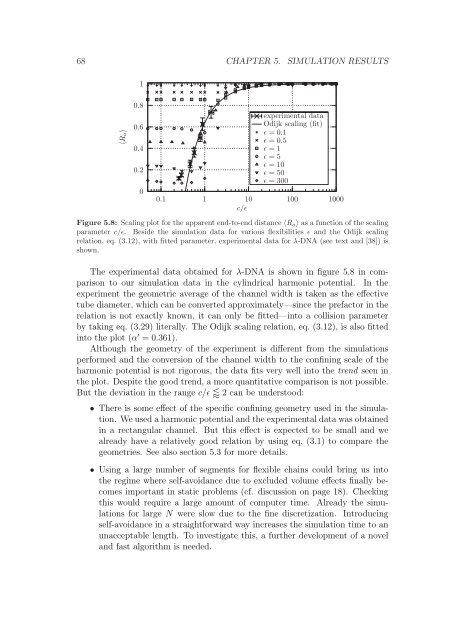Polymers in Confined Geometry.pdf
Polymers in Confined Geometry.pdf
Polymers in Confined Geometry.pdf
You also want an ePaper? Increase the reach of your titles
YUMPU automatically turns print PDFs into web optimized ePapers that Google loves.
68 CHAPTER 5. SIMULATION RESULTS<br />
〈Ra〉<br />
1<br />
0.8<br />
0.6<br />
0.4<br />
0.2<br />
0<br />
0.1<br />
1<br />
10<br />
c/ɛ<br />
experimental data<br />
Odijk scal<strong>in</strong>g (fit)<br />
ɛ = 0.1<br />
ɛ = 0.5<br />
ɛ = 1<br />
ɛ = 5<br />
ɛ = 10<br />
ɛ = 50<br />
ɛ = 300<br />
Figure 5.8: Scal<strong>in</strong>g plot for the apparent end-to-end distance 〈Ra〉 as a function of the scal<strong>in</strong>g<br />
parameter c/ɛ. Beside the simulation data for various flexibilities ɛ and the Odijk scal<strong>in</strong>g<br />
relation, eq. (3.12), with fitted parameter, experimental data for λ-DNA (see text and [38]) is<br />
shown.<br />
The experimental data obta<strong>in</strong>ed for λ-DNA is shown <strong>in</strong> figure 5.8 <strong>in</strong> comparison<br />
to our simulation data <strong>in</strong> the cyl<strong>in</strong>drical harmonic potential. In the<br />
experiment the geometric average of the channel width is taken as the effective<br />
tube diameter, which can be converted approximately—s<strong>in</strong>ce the prefactor <strong>in</strong> the<br />
relation is not exactly known, it can only be fitted—<strong>in</strong>to a collision parameter<br />
by tak<strong>in</strong>g eq. (3.29) literally. The Odijk scal<strong>in</strong>g relation, eq. (3.12), is also fitted<br />
<strong>in</strong>to the plot (α ′ = 0.361).<br />
Although the geometry of the experiment is different from the simulations<br />
performed and the conversion of the channel width to the conf<strong>in</strong><strong>in</strong>g scale of the<br />
harmonic potential is not rigorous, the data fits very well <strong>in</strong>to the trend seen <strong>in</strong><br />
the plot. Despite the good trend, a more quantitative comparison is not possible.<br />
But the deviation <strong>in</strong> the range c/ɛ 2 can be understood:<br />
100<br />
1000<br />
• There is some effect of the specific conf<strong>in</strong><strong>in</strong>g geometry used <strong>in</strong> the simulation.<br />
We used a harmonic potential and the experimental data was obta<strong>in</strong>ed<br />
<strong>in</strong> a rectangular channel. But this effect is expected to be small and we<br />
already have a relatively good relation by us<strong>in</strong>g eq. (3.1) to compare the<br />
geometries. See also section 5.3 for more details.<br />
• Us<strong>in</strong>g a large number of segments for flexible cha<strong>in</strong>s could br<strong>in</strong>g us <strong>in</strong>to<br />
the regime where self-avoidance due to excluded volume effects f<strong>in</strong>ally becomes<br />
important <strong>in</strong> static problems (cf. discussion on page 18). Check<strong>in</strong>g<br />
this would require a large amount of computer time. Already the simulations<br />
for large N were slow due to the f<strong>in</strong>e discretization. Introduc<strong>in</strong>g<br />
self-avoidance <strong>in</strong> a straightforward way <strong>in</strong>creases the simulation time to an<br />
unacceptable length. To <strong>in</strong>vestigate this, a further development of a novel<br />
and fast algorithm is needed.













